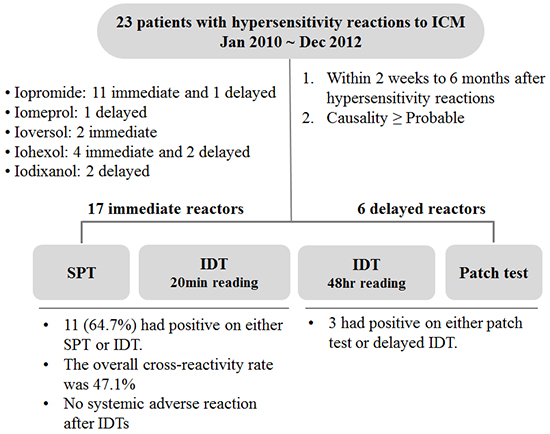1. Christiansen C. X-ray contrast media: an overview. Toxicology. 2005; 209:185–187.
2. Katzberg RW, Haller C. Contrast-induced nephrotoxicity: clinical landscape. Kidney Int Suppl. 2006; S3–S7.
3. Torvik A, Walday P. Neurotoxicity of water-soluble contrast media. Acta Radiol Suppl. 1995; 399:221–229.
4. Ye YM, Kim MK, Kang HR, Kim TB, Sohn SW, Koh YI, Park HK, Jang GC, Kim CW, Jee YK, et al. KAAACI Work Group on Urticaria/Angioedema/Anaphylaxis. Predictors of the Severity and Serious Outcomes of Anaphylaxis in Korean Adults: A Multicenter Retrospective Case Study. Allergy Asthma Immunol Res. 2015; 7:22–29.
5. Kim MH, Lee SY, Lee SE, Yang MS, Jung JW, Park CM, Lee W, Cho SH, Kang HR. Anaphylaxis to iodinated contrast media: clinical characteristics related with development of anaphylactic shock. PLoS One. 2014; 9:e100154.
6. Brockow K. Immediate and delayed cutaneous reactions to radiocontrast media. Chem Immunol Allergy. 2012; 97:180–190.
7. Webb JA, Stacul F, Thomsen HS, Morcos SK. Members of The Contrast Media Safety Committee of The European Society of Urogenital Radiology. Late adverse reactions to intravascular iodinated contrast media. Eur Radiol. 2003; 13:181–184.
8. Ring J, Arroyave CM, Frizler MJ, Tan EM. In vitro histamine and serotonin release by radiographic contrast media (RCM). Complement-dependent and -independent release reaction and changes in ultrastructure of human blood cells. Clin Exp Immunol. 1978; 32:105–118.
9. Guéant-Rodriguez RM, Romano A, Barbaud A, Brockow K, Guéant JL. Hypersensitivity reactions to iodinated contrast media. Curr Pharm Des. 2006; 12:3359–3372.
10. Brockow K. Immediate and delayed reactions to radiocontrast media: is there an allergic mechanism? Immunol Allergy Clin North Am. 2009; 29:453–468.
11. Kanny G, Maria Y, Mentre B, Moneret-Vautrin DA. Case report: recurrent anaphylactic shock to radiographic contrast media. Evidence supporting an exceptional IgE-mediated reaction. Allerg Immunol (Paris). 1993; 25:425–430.
12. Prieto-García A, Tomás M, Pineda R, Tornero P, Herrero T, Fuentes V, Zapatero L, de Barrio M. Skin test-positive immediate hypersensitivity reaction to iodinated contrast media: the role of controlled challenge testing. J Investig Allergol Clin Immunol. 2013; 23:183–189.
13. Kanny G, Pichler W, Morisset M, Franck P, Marie B, Kohler C, Renaudin JM, Beaudouin E, Laudy JS, Moneret-Vautrin DA. T cell-mediated reactions to iodinated contrast media: evaluation by skin and lymphocyte activation tests. J Allergy Clin Immunol. 2005; 115:179–185.
14. Krause W, Niehues D. Biochemical characterization of x-ray contrast media. Invest Radiol. 1996; 31:30–42.
15. Mita H, Tadokoro K, Akiyama K. Detection of IgE antibody to a radiocontrast medium. Allergy. 1998; 53:1133–1140.
16. Brockow K, Romano A, Aberer W, Bircher AJ, Barbaud A, Bonadonna P, Faria E, Kanny G, Lerch M, Pichler WJ, et al. European Network of Drug Allergy and the EAACI interest group on drug hypersensitivity. Skin testing in patients with hypersensitivity reactions to iodinated contrast media - a European multicenter study. Allergy. 2009; 64:234–241.
17. Kim SH, Jo EJ, Kim MY, Lee SE, Kim MH, Yang MS, Song WJ, Choi SI, Kim JH, Chang YS. Clinical value of radiocontrast media skin tests as a prescreening and diagnostic tool in hypersensitivity reactions. Ann Allergy Asthma Immunol. 2013; 110:258–262.
18. Torres MJ, Mayorga C, Cornejo-Garcia JA, Lopez S, Chaves P, Rondon C, Fernandez T, Blanca M. Monitoring non-immediate allergic reactions to iodine contrast media. Clin Exp Immunol. 2008; 152:233–238.
19. Wilkinson DS, Fregert S, Magnusson B, Bandmann HJ, Calnan CD, Cronin E, Hjorth N, Maibach HJ, Malalten KE, Meneghini CL, et al. Terminology of contact dermatitis. Acta Derm Venereol. 1970; 50:287–292.
20. Seong JM, Choi NK, Lee J, Chang Y, Kim YJ, Yang BR, Jin XM, Kim JY, Park BJ. Comparison of the safety of seven iodinated contrast media. J Korean Med Sci. 2013; 28:1703–1710.
21. Brockow K, Christiansen C, Kanny G, Clément O, Barbaud A, Bircher A, Dewachter P, Guéant JL, Rodriguez Guéant RM, Mouton-Faivre C, et al. ENDA. EAACI interest group on drug hypersensitivity. Management of hypersensitivity reactions to iodinated contrast media. Allergy. 2005; 60:150–158.
22. Kim SH, Lee SH, Lee SM, Kang HR, Park HW, Kim SS, Cho SH, Min KU, Kim YY, Chang YS. Outcomes of premedication for non-ionic radio-contrast media hypersensitivity reactions in Korea. Eur J Radiol. 2011; 80:363–367.
23. Blanca M, Romano A, Torres MJ, Demoly P, DeWeck A. Continued need of appropriate betalactam-derived skin test reagents for the management of allergy to betalactams. Clin Exp Allergy. 2007; 37:166–173.
24. Kvedariene V, Martins P, Rouanet L, Demoly P. Diagnosis of iodinated contrast media hypersensitivity: results of a 6-year period. Clin Exp Allergy. 2006; 36:1072–1077.
25. Dewachter P, Laroche D, Mouton-Faivre C, Bloch-Morot E, Cercueil JP, Metge L, Carette MF, Vergnaud MC, Clément O. Immediate reactions following iodinated contrast media injection: a study of 38 cases. Eur J Radiol. 2011; 77:495–501.
26. Torres MJ, Gomez F, Doña I, Rosado A, Mayorga C, Garcia I, Blanca-Lopez N, Canto G, Blanca M. Diagnostic evaluation of patients with nonimmediate cutaneous hypersensitivity reactions to iodinated contrast media. Allergy. 2012; 67:929–935.









 PDF
PDF ePub
ePub Citation
Citation Print
Print




 XML Download
XML Download